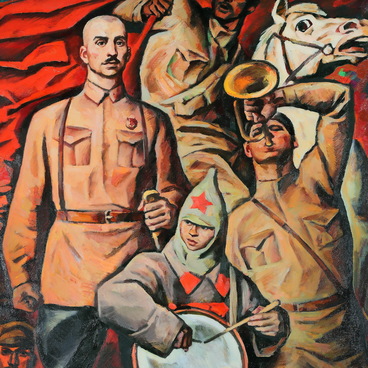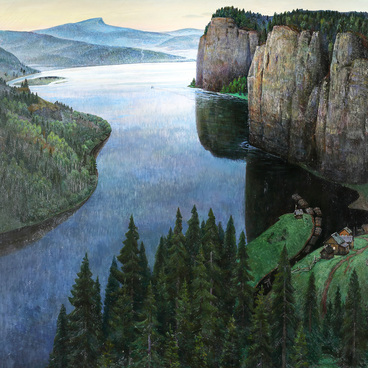The big canvas of the 1977 painting “Sunny Day” created by the Ural painter Viktor Dobrovolsky combines elements of urban landscape and genre painting. This work also features details that are characteristic of the painter’s style — bright and cheerful colors, a touch of lightness, and a festive mood.
Dobrovolsky chose to set the composition of his painting in Ploshchad Truda, the oldest square of Sverdlovsk (modern Yekaterinburg) located in the historical part of the city. The previous names of the square include Tserkovnaya, Sobornaya, and Yekaterininskaya. The last name is associated with the 18th-century Catherine’s Cathedral. The iconic Baroque building was demolished in the early 1930s. A public garden was established in its place and became a favorite walking spot of the townspeople. A few decades later, the garden welcomed a fountain called “The Stone Flower” made according to the project of the Sverdlovsk architect Pyotr Dmitrievich Demintsev. It was inspired by the famous malachite flower from the story by Pavel Petrovich Bazhov. The fountain was shaped like a round pool and was faced with pink marble. The flower on the Siberian granite pedestal was made by Kamensk-Uralsky craftsmen from cast iron.
The Ploshchad Truda square in the painting is filled with figures of adults and children enjoying a fine winter day. The multifigured complex composition is lively and elaborate. It renders the crisp atmosphere of a sunny day with bright shadows reflected on the trampled snow, white and blue lacing of frosted trees and clothes of people that fill the foreground and the middle ground around the famous fountain. The background reveals buildings and streets with red trams and cars.
All the people, houses, and trees seem intertwined in a cheerful circle dance. The foreground is filled with expressive figures and details: a serious-looking man in a shapka-pirozhok (Russian headdress) strolling with his hands behind his back and a newspaper in his pocket, a young long-haired man in bell-bottoms holding a rose and wearing a cassette bag with stickers featuring images of popular singers, and a string bag hanging over the fence bearing apples and cellophane gift wrap.
The artist managed to convey the peculiarities in the clothes and behavior of people in the 1970s, as well as many urban subtleties of that time. Most importantly, he reflected the joy given by a sunny day through cheerful colors and the mosaic manner of painting.
Dobrovolsky loved winter landscapes most of all, which is why they turned out so expressive and rich in detail.
Dobrovolsky chose to set the composition of his painting in Ploshchad Truda, the oldest square of Sverdlovsk (modern Yekaterinburg) located in the historical part of the city. The previous names of the square include Tserkovnaya, Sobornaya, and Yekaterininskaya. The last name is associated with the 18th-century Catherine’s Cathedral. The iconic Baroque building was demolished in the early 1930s. A public garden was established in its place and became a favorite walking spot of the townspeople. A few decades later, the garden welcomed a fountain called “The Stone Flower” made according to the project of the Sverdlovsk architect Pyotr Dmitrievich Demintsev. It was inspired by the famous malachite flower from the story by Pavel Petrovich Bazhov. The fountain was shaped like a round pool and was faced with pink marble. The flower on the Siberian granite pedestal was made by Kamensk-Uralsky craftsmen from cast iron.
The Ploshchad Truda square in the painting is filled with figures of adults and children enjoying a fine winter day. The multifigured complex composition is lively and elaborate. It renders the crisp atmosphere of a sunny day with bright shadows reflected on the trampled snow, white and blue lacing of frosted trees and clothes of people that fill the foreground and the middle ground around the famous fountain. The background reveals buildings and streets with red trams and cars.
All the people, houses, and trees seem intertwined in a cheerful circle dance. The foreground is filled with expressive figures and details: a serious-looking man in a shapka-pirozhok (Russian headdress) strolling with his hands behind his back and a newspaper in his pocket, a young long-haired man in bell-bottoms holding a rose and wearing a cassette bag with stickers featuring images of popular singers, and a string bag hanging over the fence bearing apples and cellophane gift wrap.
The artist managed to convey the peculiarities in the clothes and behavior of people in the 1970s, as well as many urban subtleties of that time. Most importantly, he reflected the joy given by a sunny day through cheerful colors and the mosaic manner of painting.
Dobrovolsky loved winter landscapes most of all, which is why they turned out so expressive and rich in detail.

